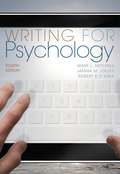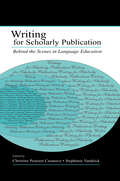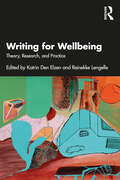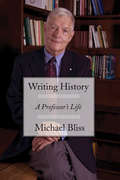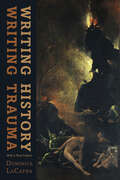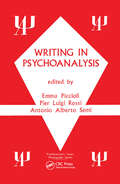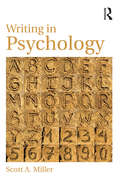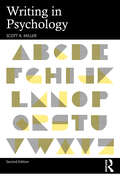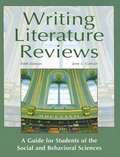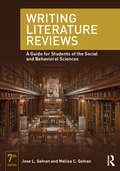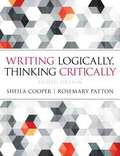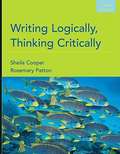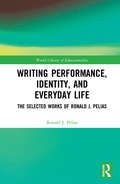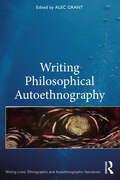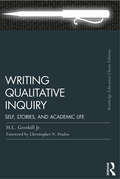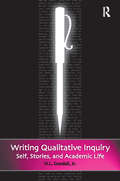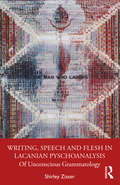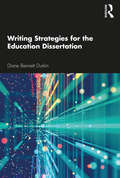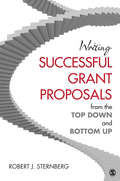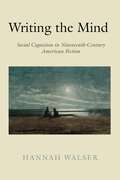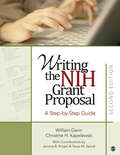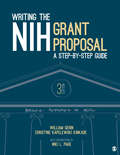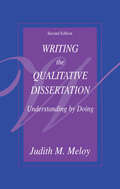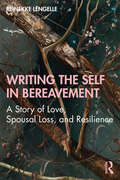- Table View
- List View
Writing for Psychology
by Janina M. Jolley Mark L. Mitchell Robert P. O'SheaWRITING FOR PSYCHOLOGY, Fourth Edition offers concise assistance for students writing their research analyses using APA style. By providing concrete examples of common errors, the authors show rather than merely tell students what to do and what to avoid. This manual will help students adhere to the basics of APA style; refine critical thinking skills, library search skills, revising skills, editing skills, and proofing skills; and avoid plagiarism. Checklists precede a summary at the end of every chapter, giving students the chance to make sure they have been thorough in their reports.
Writing for Scholarly Publication: Behind the Scenes in Language Education
by Stephanie Vandrick Christine Pearson CasanaveThis collection of first-person essays by established authors provides a wealth of support and insights for new and experienced academic writers in language education and multicultural studies. Although writing for publication is becoming increasingly important as these fields become both more professional and more competitive, few scholars talk candidly about their experiences negotiating a piece of writing into print. These essays will help researchers, practitioners, and graduate students expand their understanding of what it means--professionally and personally--to write for publication. Carefully crafted, focused, and provocative, the chapters in this volume document authors' experiences with a range of practical, political, and personal issues in writing for publication. Many portray the hardship and struggle that are not obvious in a finished piece of writing. Readers are encouraged to resonate with the events and issues portrayed, and to connect the narratives to their own lives. Practical information, such as contact information for journal and book publishers, manuscript guidelines, and useful books are included in appendices. Although organized thematically, the essays in Writing for Scholarly Publication: Behind the Scenes in Language Education overlap in many ways as each author considers multiple issues: *In the Introduction, the editors discuss key aspects of writing for scholarly publication, such as writing as situated practice, issues faced by newcomers, the construction of personal identity through writing, writing and transparency, facets of the interactive nature of scholarly writing, and intertwined political issues. *Part I focuses on issues and concerns faced by "Newcomers." *In Part II, "Negotiating and Interacting," the essays closely examine the interactions among authors, editors, manuscript reviewers, and collaborators; these interactions tend to be the least often discussed and these essays therefore offer readers fascinating insights into the sensitive social, political, and personal relationships among the many players in the scholarly writing game. *"Identity Construction" is addressed in Part III, where authors share their experiences with and reflections on the ways that professional writing helps them construct their identities as writers and scholars. *The essays in Part IV, "From the Periphery," help redefine what the notion of "periphery" might mean, from a concept with a negative connotation of "outsider" to a positive connotation of active and unconventional participant.
Writing for Wellbeing: Theory, Research, and Practice
by Katrin Den Elzen Reinekke LengelleWriting can support our wellbeing even under the most difficult life circumstances, helping us to adapt to significant change, make sense of loss, improve our physical and emotional resilience, and foster personal growth. Numerous studies of Expressive Writing have confirmed this, and there are other established methodologies for practice. However, to date, few accounts have offered detailed descriptions showing how and why putting pen to paper can be so beneficial. This book delves deeply into the landscape of Writing-for-wellbeing and demonstrates the transformative power of writing in a wide range of contexts. Topics include personal trauma narratives within the Humanities; a participatory Writing-for-wellbeing study that demonstrates the effectiveness of writing in the context of grief and loss; surprise as the hidden mainspring of poetry's therapeutic potency; the empowerment and healing potential offered by Black women’s blogs; playwriting positioning LGBTQIA+ identities as positive through stories of belonging; how writing workshops have helped newly literate Indigenous adults and other participants in the Australian outback; and how the smuggled writings of Behrouz Boochani have enabled global witnessing of the stories of refugees held in offshore detention. This resource sets out the theory and research at the foundation of Writing-for-wellbeing in close relation to full and engaging accounts of practice. It aims to make the topic accessible and affirms its place as an effective reconstructive practice alongside other expressive arts therapies, providing a holistic and inspiring resource for anyone wishing to practice, teach, or research Writing-for-wellbeing.
Writing History: A Professor’s Life
by Michael BlissOne of Canada’s best-known and most-honoured biographers turns to the raw material of his own life in Writing History. A university professor, prolific scholar, public intellectual, and frank critic of the world he has known, Michael Bliss draws on extensive personal diaries to describe a life that has taken him from small-town Ontario in the 1950s to international recognition for his books in Canadian and medical history. His memoir ranges remarkably widely: it encompasses social history, family tragedy, a critical insider’s view of university life, Canadian national politics, and, above all, a rare glimpse into the craftsmanship that goes into the research and writing of history in our time. Whether writing about pigs and millionaires, the discovery of insulin, sleazy Canadian politicians, or the founders of modern medicine and brain surgery, Michael Bliss is noted for the clarity of his prose, the honesty of his opinions, and the breadth of his literary interests.
Writing History, Writing Trauma (Parallax: Re-visions of Culture and Society)
by Dominick LaCapraAn updated edition of a major work in trauma studies.Trauma and its aftermath pose acute problems for historical representation and understanding. In Writing History, Writing Trauma, Dominick LaCapra critically analyzes attempts by theorists and literary critics to come to terms with trauma and with the crucial role post-traumatic testimonies—notably Holocaust testimonies—assume in thought and in writing. These attempts are addressed in a series of six interlocking essays that adapt psychoanalytic concepts to historical analysis, while employing sociocultural and political critique to elucidate trauma and its aftereffects in culture and in people. This updated edition includes a substantive new preface that reconsiders some of the issues raised in the book.
Writing in Psychoanalysis
by Giorgio Sacerdoti Parthenope Bion Talamo John E. Gedo Francesco Barale Patrick Mahony Henning Paikin Fausto Petrella Antonio Alberto SemiA beautiful and thoughtful collection of essays on reading, writing and learning, Writing and Psychoanalysis grows out of a colloquium. The results are wondrous and impact on the reader at many different levels. In the act of writing, we all discover something about what we know previously unknown to us, and we learn more about our inner world that we knew before we set pen to paper (or hand to computer). Patrick Mahony goes so far as to argue that Freud's self-analysis was essentially a "writing cure." Writing in Psychoanalysis is the first volume in the projected Monograph Series, Psychoanalytic Issues, the Rivista di Psicoanalisi (the Journal of the Italian Psychoanalytical Society) is undertaking in conjunction with Karnac Books. This series constitutes a major effort to bring about a dialogue among psychoanalysts who while ultimately bound together by a common psychoanalytic heritage nonetheless are separated in their thinking by different idioms, whether linguistic or theoretical. While featuring writers of very different idioms, this series will also present a venue to make some important Italian voices known to English speaking analysts.
Writing in Psychology
by Scott A. MillerThis book helps readers become better writers of psychology and better writers in general. After reading thousands of course papers, theses, and dissertations, Dr. Miller knows and addresses the issues that students find most challenging when writing about psychology. Written with the utmost flexibility in mind, the chapters can be read in any order. More comprehensive than similar texts, this book provides detailed coverage of how to write empirical reports, research proposals, and literature reviews, and how to read meta-analyses. Readers will also find invaluable strategies for improving one’s writing including how to adopt an engaging yet accurate style, thorough coverage of grammatical and word use rules that govern writing in general, and the APA (American Psychological Association) rules that govern the expression of that content. Readers will appreciate these helpful learning tools: Describes the most common APA style rules encountered and/or highlights references to the Manual when more detailed knowledge is required. Numerous examples from journal articles that help readers gain a clearer understanding of content they will encounter in writing psychological reports. Chapter exercises that provide an opportunity to apply the points conveyed in each chapter. Examples of the most common mistakes made by students and how to avoid them and best practices for improving one’s writing. Tables that help readers gain a clearer understanding of the new standards in the APA Publications Manual, 6th ed (Appendix A). Errors in APA Style exemplified via an improperly formatted paper and another version noting corrections pertaining to APA style and grammar, to highlight the most common pitfalls encountered by students (Appendix B). Ideal for courses on writing in psychology or as a supplement for graduate or advanced undergraduate courses in research design or research methods, this book also serves as a resource for anyone looking for guidance on how to write about psychological content.
Writing in Psychology
by Scott A. MillerThe second edition of Writing in Psychology by Scott A. Miller is a comprehensive guide to addressing the most challenging issues that students face while writing about psychology, including what to say and how to say it. It offers practical tools to overcome the challenges and create an engaging work. The book is a valuable resource for helping readers become better writers of psychology with the aid of various helpful learning tools, which provide detailed coverage of how to write empirical reviews, research proposals, literature reviews, term papers, and posters. It examines examples from journal articles that give readers a grasp of the content they will encounter in writing psychological reports. Furthermore, it includes exercises that provide an opportunity to apply the points conveyed in each chapter, examples of ways to avoid the most common mistakes made by students, and a guide to the best practices for improving one’s writing. Readers will also develop a thorough understanding of how to write in an engaging yet accurate style, using grammatical and word use rules that govern writing in general, and the rules of seventh edition APA (American Psychological Association) Publication Manual that determine the expression of that content. Throughout, the book emphasizes inclusion, diversity, and fair treatment of those with whom psychologists deal, in research and writing. The book will benefit anyone looking for guidance on how to write about psychological content. It is ideal for research scholars and psychology students as a primary text for writing in psychology courses and a supplement for graduate or advanced undergraduate courses in research design or research methods.
Writing Literature Reviews: A Guide for Students of the Social and Behavioral Sciences
by Jose L. GalvanThis easy-to-follow guide instructs students in the preparation of literature reviews for term projects, theses, and dissertations. There are numerous examples from published literature reviews that illustrate the guidelines discussed in this text. New to this edition: Most of the examples have been updated with material from recently published research. Also new: Seven new model literature reviews for discussion and evaluation have been added. Guides students in the preparation of literature reviews for term projects, theses, and dissertations. Chapters are conveniently divided into easy-to-follow guidelines, sequential steps, or checklists. Numerous examples throughout the book show students what should and should not be done when writing reviews. Emphasizes critical analysis of reports of empirical research in academic journals-making it ideal as a supplement for research methods courses. This book makes it possible for students to work independently on a critical literature review as a term project. Nine model literature reviews at the end of the book provide the stimulus for homework assignments and classroom discussions. The activities at the end of each chapter keep students moving toward their goal of writing a polished, professional review of academic literature. New to this edition: Most of the examples have been updated with material from recently published research. Also new: Seven new model literature reviews for discussion and evaluation have been added.
Writing Literature Reviews: A Guide for Students of the Social and Behavioral Sciences
by Jose L. Galvan Melisa C. GalvanThis useful guide educates students in the preparation of literature reviews for term projects, theses, and dissertations. The authors provide numerous examples from published reviews that illustrate the guidelines discussed throughout the book. New to the seventh edition: Each chapter breaks down the larger holistic review of literature exercise into a series of smaller, manageable steps Practical instructions for navigating today’s digital libraries Comprehensive discussions about digital tools, including bibliographic and plagiarism detection software Chapter activities that reflect the book’s updated content New model literature reviews Online resources designed to help instructors plan and teach their courses (www.routledge.com/9780415315746).
Writing Logically, Thinking Critically
by Sheila Cooper Rosemary PattonThis concise, accessible text teaches students how to write logical, cohesive arguments and how to evaluate the arguments of others. Integrating writing skills with critical thinking skills, this practical book teaches students to draw logical inferences, identify premises and conclusions and use language precisely. Students also learn how to identify fallacies and to distinguish between inductive and deductive reasoning. Ideal for any composition class that emphasizes argument, this text includes coverage of writing style and rhetoric, logic, literature, research and documentation.
Writing Logically, Thinking Critically (6th Edition)
by Sheila Cooper Rosemary PattonThis concise, accessible text teaches students how to write logical, cohesive arguments and how to evaluate the arguments of others. Integrating writing skills with critical thinking skills, this practical book teaches students to draw logical inferences, identify premises and conclusions and use language precisely. Students also learn how to identify fallacies and to distinguish between inductive and deductive reasoning. Ideal for any composition class that emphasizes argument, this text includes coverage of writing style and rhetoric, logic, literature, research and documentation.
Writing Performance, Identity, and Everyday Life: The Selected Works of Ronald J. Pelias
by Ronald J. PeliasWriting Performance, Identity, and Everyday Life invites the reader into Ronald J. Pelias’ world of artistic and everyday performance. Calling upon a broad range of qualitative methods, these selected writings from Pelias submerge themselves in the evocative and embodied, in the material and consequential, often creating moving accounts of their topics. The book is divided into four sections: Foundational Logics, Performance, Identity, and Everyday Life. Part I addresses the methodological underpinnings of the book, focusing on the ‘touchstones’ that inform Pelias’ work: performative, autoethnographic, poetic, and narrative methods. These directions push the researcher toward empathic engagement, a leaning toward others; using the literary to evoke the cognitive and affective aspects of experience; and an ethical sensibility located in social justice. Parts II–IV focus on artistic and everyday life performances, including discussions of the disciplinary shift from the oral interpretation of literature to the field of performance studies; empathy and the actor’s process; conceptions of performance; the performance of race, gender, and sexuality; and performances in interpersonal relations and academic circles. By the end, readers will see Pelias demonstrate the power of qualitative methods to engage and to present alternative ways of being. Pelias’ work shows us how to understand and feel the evocative strength of thinking performatively.
Writing Philosophical Autoethnography (Writing Lives: Ethnographic and Autoethnographic Narratives)
by Alec GrantWriting Philosophical Autoethnography is the result of Alec Grant’s vision of bringing the disciplines of philosophy and autoethnography together. This is the first volume of narrative autoethnographic work in which invited contributing authors were charged with exploring their issues, concerns, and topics about human society, culture, and the material world through an explicitly philosophical lens. Each chapter, while written autoethnographically, showcases sustained engagement with philosophical arguments, ideas, concepts, theories, and corresponding ethical positions. Unlike much other autoethnographic work, within which philosophical ideas often appear to be "grafted on" or supplementary, the philosophical basis of the work in this volume is fundamental to its shifting content, focus, and context. The narratives in this book, from scholars working in a range of disciplines in the humanities and human sciences, function as narrative, conceptual, and analytical exemplars to act as a guide for autoethnographers in their own writing, and suggest future directions for making autoethnography more philosophically rigorous. This book is suitable for students and scholars of autoethnography and qualitative methods in a range of disciplines, including the humanities, social and human sciences, communication studies, and education.
Writing Qualitative Inquiry: Self, Stories, and Academic Life (Writing Lives Ser. #6)
by H.L. Goodall JrNow issued as a Routledge Education Classic Edition, Bud Goodall’s Writing Qualitative Inquiry responds to the rapid growth of personal narrative as a method of inquiry among qualitative scholars by offering a concise volume of practical advice for scholars and students seeking to work in this tradition. He provides writing tips and strategies from a well-published, successful author of creative nonfiction and concrete guidance on finding appropriate outlets for your work. For readers, he offers a set of criteria to assess the quality of creative nonfiction writing. Goodall suggests paths to success within the academy—still rife with political sinkholes for the narrative ethnographer—and ways of building a career as a public scholar. Goodall’s work serves as both a writing manual and career guide for those in qualitative inquiry. A new foreword by Christopher N. Poulos reflects on Bud Goodall’s life and work, and the impact of this book on narrative writing.
Writing Qualitative Inquiry: Self, Stories, and Academic Life (Writing Lives: Ethnographic Narratives #6)
by H.L. Goodall JrResponding to the rapid growth of personal narrative as a method of inquiry among qualitative scholars, Bud Goodall offers a concise volume of practical advice for scholars and students seeking to work in this tradition. He provides writing tips and strategies from a well-published, successful author of creative nonfiction and concrete guidance on finding appropriate outlets for your work. For readers, he offers a set of criteria to assess the quality of creative nonfiction writing. Goodall suggests paths to success within the academy—still rife with political sinkholes for the narrative ethnographer—and ways of building a career as a public scholar. Goodall’s work serves as both a writing manual and career guide for those in qualitative inquiry.
Writing, Speech and Flesh in Lacanian Psychoanalysis: Of Unconscious Grammatology
by Shirley ZisserThis book explores the place of the flesh in the linguistically-inflected categories of Freudian and Lacanian psychoanalysis, drawing explicit attention to the organic as an inherent part of the linguistic categories that appear in the writings of Freud and Lacan. Lacan’s ‘return to Freud’ famously involves a ‘linguistic turn’ in psychoanalysis. The centering of language as a major operator in psychic life often leads to a dualistic or quasi-dualistic view in which language and the enjoyment of the body are polarized. Exploring the intricate connections of the linguistic and the organic in both Lacanian and Freudian psychoanalysis from its beginnings, Zisser shows that surprisingly, and not only in Lacan’s late teaching, psycho-linguistic categories turn out to be suffused with organicity. After unfolding the remnant of the flesh in the signifier as a major component of Lacan’s critique of Saussure, using visual artworks as objective correlatives as it does so, the book delineates two forms of psychic writing. These are aligned not only with two fundamental states of the psychic apparatus as described by Freud (pain and satisfaction), but with two ways of sculpting formulated by Alberti in the Renaissance but also referred to by Freud. Continuing in a Derridean vein, the book demonstrates the primacy of writing to speech in psychoanalysis, emphasizing how the relation between speech and writing is not binary but topological, as speech in its psychoanalytic conception is nothing but the folding inside-out of unconscious writing. Innovatively placing the flesh at the core of its approach, the text also incorporates the seminal work of psychoanalyst Michèle Montrelay to articulate the precise relation between the linguistic and the organic. Writing, Speech and Flesh in Lacanian Psychoanalysis will be indispensable to psychoanalysts, literary theorists, rhetoricians, deconstructionists, and those studying at the intersection of psychoanalysis, language, and the visual arts.
Writing Strategies for the Education Dissertation
by Diane Bennett DurkinWriting Strategies for the Education Dissertation offers a unique take on doctoral writing. It uses composition and rhetoric strategies to identify key activities for generating thought to keep students writing. It de-mythologizes the view of writing as a mere skill and promotes the view of writing as thinking. It uses writing to help students invent, think through, write, rethink, and rewrite as they develop and present their innovations. The book opens with this mindset and with the purposes of the task (adding to knowledge); it helps define a "researchable topic," and provides advice on invention ("brainstorming"). It then addresses each of the key sections of the dissertation, from Problem Statement, through Literature Review and Methods, to Findings and Conclusions, while underscoring the iterative nature of this writing. For each chapter, the book provides advice on invention, argument, and arrangement ("organization") – rhetorical elements that are seldom fully addressed in textbooks. Each chapter also looks at possible missteps, offers examples of student writing and revisions, and suggests alternatives, not rules. The text concludes with an inventive approach of its own, addressing style (clarity, economy, and coherence) as persuasion. This book is suitable for all doctoral students of education and others looking for tips and advice on the best dissertation writing.
Writing Successful Grant Proposals from the Top Down and Bottom Up
by Dr Robert J. SternbergThis text provides comprehensive advice on how to build a successful grant proposal, from the top down and from the bottom up. Editor Robert J. Sternberg gathers editorial expertise from distinguished members of associations in the Federation of Associations of Behavioral and Brain Sciences, which includes some of the most successful grant applicants and grant givers in the field of brain and behavioral sciences. The chapter authors offer readers practical advice on planning, executing, submitting, and revising grant proposals in order to maximize their chances of success. Exploring both grant writers' and grant providers' perspectives, Writing Successful Grant Proposals from the Top Down and Bottom Up provides valuable insight into general strategies on how to write and submit proposals, as well as detailed information on the various types of proposals needed to reach particular research and teaching goals.
Writing the Mind: Social Cognition in Nineteenth-Century American Fiction
by Hannah WalserNovels are often said to help us understand how others think—especially when those others are profoundly different from us. When interpreting a character's behavior, readers are believed to make use of "Theory of Mind," the general human capacity to attribute mental states to other people. In many well-known nineteenth-century American novels, however, characters behave in ways that are opaque to readers, other characters, and even themselves, undermining efforts to explain their actions in terms of mental states like beliefs and intentions. Writing the Mind dives into these unintelligible moments to map the weaknesses of Theory of Mind and explore alternative frameworks for interpreting behavior. Through readings of authors such as Charles Brockden Brown, Herman Melville, Martin Delany, Harriet Beecher Stowe, Charles Chesnutt, and Mark Twain, Hannah Walser explains how experimental models of cognition lead to some of the strangest formal features of canonical American texts. These authors' attempts to found social life on something other than mental states not only invite us to revise our assumptions about the centrality of mind reading and empathy to the novel as a form; they can also help us understand more contemporary concepts in social cognition, including gaslighting and learned helplessness, with more conceptual rigor and historical depth.
Writing the NIH Grant Proposal: A Step-by-Step Guide
by William Gerin Christine Kapelewski Kinkade Jerome R. Itinger Tanya SpruillHands-on advice that simplifies, demystifies, and takes the fear out of writing a NIH grant proposal This fully updated book takes readers through the complex issues involved in applying for a prestigious NIH grant—from training grants to full-blown research awards. Actual forms from NIH grant applications—including the PHS 398 and the new SF 424 forms—are annotated to provide readers with step-by-step guidance that highlights unexpected nuances that can make all the difference between winning and losing a grant.
Writing the NIH Grant Proposal: A Step-by-Step Guide
by William Gerin Christine Kapelewski Kinkade Niki L. PageAuthors William Gerin, Christine Kapelewski, and Niki L. Page are here to help you secure NIH funding for your research! Writing the NIH Grant Proposal, Third Edition offers hands-on advice that simplifies, demystifies, and takes the fear out of writing a federal grant application. Acting as a virtual mentor, this book provides systematic guidance for every step of the NIH application process, including the administrative details, developing and managing collaborative relationships, budgeting, and building a research team. Helpful hints along the way provide tips from researchers who have received grants themselves. New to this Edition: Much more user-friendly in response to the updated NIH website Covers the new Application Submission System & Interface for Submission Tracking (ASSIST) online submission form for both single and multiple projects Revamped advice on substantive sections of the proposal to address lowered page allowance Coverage of the new scoring system and reviewer reporting system Coverage of the usage and submission of the new SF 424 forms
Writing the NIH Grant Proposal: A Step-by-Step Guide
by William Gerin Christine Kapelewski Kinkade Niki L. PageAuthors William Gerin, Christine Kapelewski, and Niki L. Page are here to help you secure NIH funding for your research! Writing the NIH Grant Proposal, Third Edition offers hands-on advice that simplifies, demystifies, and takes the fear out of writing a federal grant application. Acting as a virtual mentor, this book provides systematic guidance for every step of the NIH application process, including the administrative details, developing and managing collaborative relationships, budgeting, and building a research team. Helpful hints along the way provide tips from researchers who have received grants themselves. New to this Edition: Much more user-friendly in response to the updated NIH website Covers the new Application Submission System & Interface for Submission Tracking (ASSIST) online submission form for both single and multiple projects Revamped advice on substantive sections of the proposal to address lowered page allowance Coverage of the new scoring system and reviewer reporting system Coverage of the usage and submission of the new SF 424 forms
Writing the Qualitative Dissertation: Understanding by Doing
by Judith M. MeloyThe purpose of this book is to share, in rich detail, an understanding of how it feels and what it means to do qualitative research, and to provide support for doctoral students who choose this form of inquiry for their dissertation research.
Writing the Self in Bereavement: A Story of Love, Spousal Loss, and Resilience (Writing Lives: Ethnographic Narratives)
by Reinekke LengelleIn Writing the Self in Bereavement: A Story of Love, Spousal Loss, and Resilience, Reinekke Lengelle uses her abilities as a researcher, poet, and professor of therapeutic writing to tell a heartfelt and fearless story about her grief after the death of her spouse and the year and a half following his diagnosis, illness, and passing. This book powerfully demonstrates that writing can be a companion in bereavement. It uses and explains the latest research on coming to terms with spousal loss without being prescriptive. Integrated with this contemporary research are stories, poetry, and reflections on writing as a therapeutic process. The author unflinchingly explores a number of themes that are underrepresented in existing resources: how one deals with anger associated with loss, what a healthy response might be to unfinished business with the deceased, continuing conversations with the beloved (even for agnostics and atheists), ongoing sexual desire, and secondary losses. As a rare book where an author successfully combines a personal story, heart-rending poetry, up-to-date research on grief, and an evocative exploration of taboo topics in the context of widowhood, Writing the Self in Bereavement is uniquely valuable for those grieving a spouse or other loved one, those supporting others in bereavement, and those interested in the healing power of poetry and life writing. Researchers on death and dying, grief counsellors, and autoethnographers will also benefit from reading this resonant resource on love and loss.
